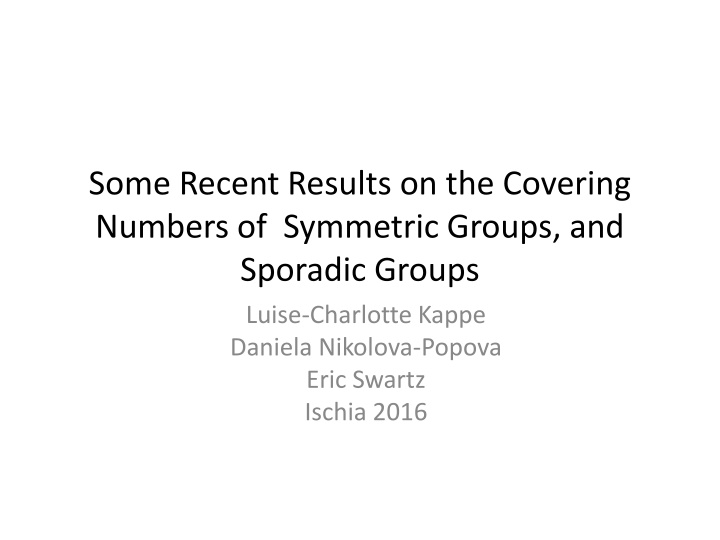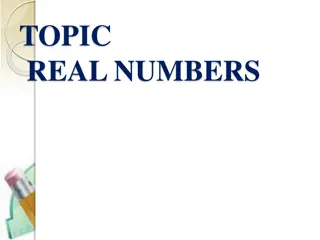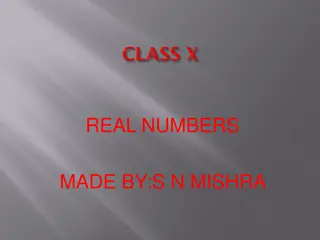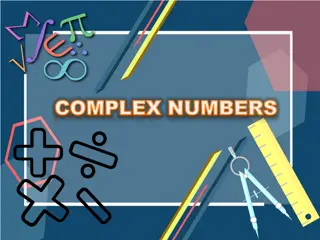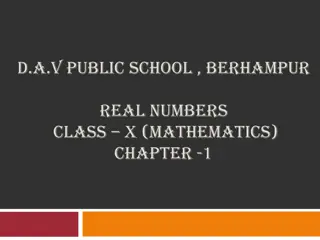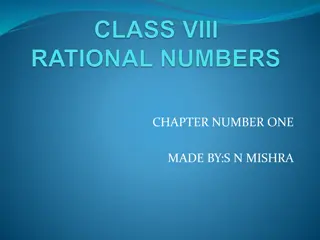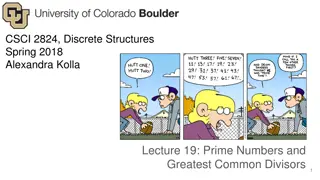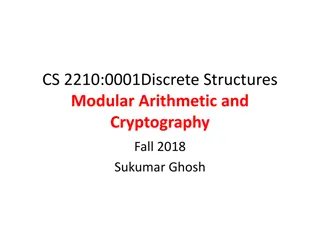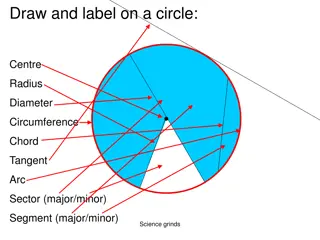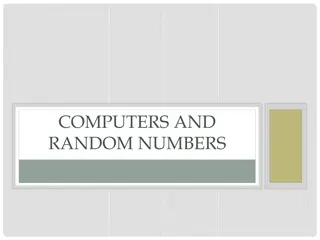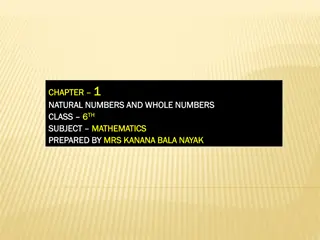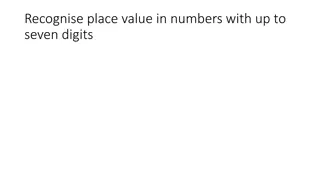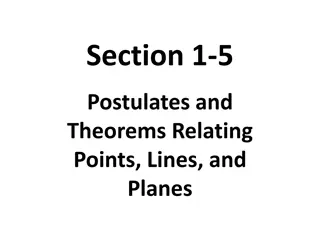Recent Progress on Group Covering Numbers and Theorems
Recent advancements in group theory regarding covering numbers of symmetric groups, sporadic groups, linear groups, Suzuki groups, and sporadic simple groups. Theorems and results from various researchers are highlighted using GAP calculations, linear programming, and graph theory.
Download Presentation

Please find below an Image/Link to download the presentation.
The content on the website is provided AS IS for your information and personal use only. It may not be sold, licensed, or shared on other websites without obtaining consent from the author.If you encounter any issues during the download, it is possible that the publisher has removed the file from their server.
You are allowed to download the files provided on this website for personal or commercial use, subject to the condition that they are used lawfully. All files are the property of their respective owners.
The content on the website is provided AS IS for your information and personal use only. It may not be sold, licensed, or shared on other websites without obtaining consent from the author.
E N D
Presentation Transcript
Some Recent Results on the Covering Numbers of Symmetric Groups, and Sporadic Groups Luise-Charlotte Kappe Daniela Nikolova-Popova Eric Swartz Ischia 2016
Abstract We say that a group G has a finite covering if G is a set theoretical union of finitely many proper subgroups. The minimal number of subgroups needed for such a covering is called the covering number of G denoted by (G). Let Snbe the symmetric group on n letters. For odd n Maroti determined (Sn)= 2n-1with the exception of n = 9, and gave estimates for n even showing that (Sn) 2n-2. Using GAP calculations, as well as incidence matrices and linear programming, we show that (S8) = 64, (S10) = 221, (S12) = 761. We also show that Maroti s result for odd n holds without exception proving that (S9)=256. We establish in addition that (A9)=157, (A11)=2751, the Mathieu group m12has covering number 208, and improve the estimate for the Janko group J1given by P.E. Holmes.
The Covering Number Theorem 1 (Tomkinson,1997): Let G be a finite soluble group and let p be the order of the smallest chief factor having more that one complement. Then (G) = p +1. The author suggested the investigation of the covering number of simple groups.
Linear Groups Theorem 2 (Bryce, Fedri, Serena, 1999) (G)=1/2 q(q+1) when q is even, (G)=1/2 q(q+1)+1 when q is odd, where G=PSL(2,q), PGL(2,q), or GL(2,q), and q 2, 5, 7, 9.
Suzuki Groups Theorem 3 (Lucido, 2001) (Sz(q)) = q2(q2+1), where q = 22m+1.
Sporadic Simple Groups Theorem 6 (P.E. Holmes, 2006) (m11)=23, (m22)= 771, (m23)=41079, (Ly) = 112845655268156, (O N) = 36450855 5165 (J1) 5415 24541 (McL) 24553. The author has used GAP, the ATLAS, and Graph Theory.
Symmetric and Alternating Groups Theorem 4 (Maroti, 2005) (Sn) = 2n-1if n is odd, n 9 (Sn) 2n-2if n is even. (An) 2n-2if n 7,9, and (An)= 2n-2if n is even but not divisible by 4. (A7) 31, and (A9) 80.
Alternating Groups Theorem 5 (Luise-Charlotte Kappe, Joanne Redden, 2009) (A7)= 31 (A8) = 71 127 (A9) 157 (A10) = 256.
Recent results We can now prove the exact numbers: (S8) = 64. (S9) = 256. (S10)=221. (S12)=761. (A9) = 157. (A11) = 2751. 5316 (J1) 5413.
Starting point It is sufficient to consider the number of maximal subgroups of G needed to cover all maximal cyclic subgroups of G. We used GAP for the distribution of the elements in the maximal subgroups We first estimated the limits by a Greedy Algorithm.
Note: Easy case: When the elements are partitioned into the subgroups of a conjugacy class. Harder case: When the elements of a certain cyclic structure are not partitioned. Further Approaches: Incidence matrices and Combinatorics Linear programming
S7 Maximal subgroups MS1 = A_7 Order of Class Representative 2520 Size 1 MS2 = S_6 720 7 MS3 = S_3 x S_4 144 35 MS4 = C_2 x S_5 240 21 MS5 = (C_7:C_3):C_2 42 120
Distribution of the Elements of S7: Ord er 1 2 2 2 3 3 4 4 5 6 6 6 7 10 12 Cyclic Structure 1 (12) (12)(34) (12)(34)(56) (123) (123)(456) (1234) (1234)(56) (12345) (123456) (123)(45) (123)(45)(67) (1234567) (12345)(67) (1234)(567) Size MS1=A_7 MS2 MS3 MS4 MS5 1 21 1 0 X 0 X X 0 X X 0 0 X X 0 0 15 9 11 0 105 15,P 9 15 7 210 90 6,P 30 0 840 420 120,P 120 0 36 0 40 14 0 720 504 420 0 0 0 12,P 24,P 0 0 0
S7 It is clear from the table why = 27-1 The group is covered by A7 (MS1), the 7 groups S6 in MS2, the 35 groups in MS3, and the 21 groups in MS4: 1+7+35+21=64=26. (S7) = 64.
S8 Maximal subgroups Order of Class Representative Size MS1 = A_8 20160 1 MS2 = S_3 x S_5 720 56 MS3 = C_2 x S_6 1440 28 MS4 = S_7 5040 8 MS5=((((C_2xD_8):C_2):C_3):C_2):C_2 384 105 MS6 = (S_4 x S_4): C_2 1152 35 MS7 = PSL(3,2): C_2 336 120
Distribution of Elements: S8 Order Cyclic Structure Size MS1 MS2 MS3 MS4 MS5 MS6 MS7 1 2 2 2 2 1 21 22 23 24 1 28 210 420 105 1 0 210, P 0 105, P 1 13(26) 45(12) 45(6) 0 1 16(16) 60(8) 60(4) 15(4) 1 21(6) 105(4) 105(2) 0 1 4(15) 18(9) 28(7) 25(25) 1 12(15) 42(7) 36(3) 33(11) 1 0 0 28(8) 21(24) 31 2x4 3 4 112 2520 112, P 2520,P 22(11) 90(2) 40(10) 180(2) 70(5) 630(2) 0 24,P 16(5) 72,P 0 0 41 22x 4 4 4 420 1260 0 0 30(4) 0 90(6) 90(2) 210(4) 0 12(3) 36(3) 12,P 180(5) 0 0 42 4 1260 1260,P 0 0 0 60(5) 108(3) 42(4) 5 5 1344 1344,P 24,P 144(3) 504(3) 0 0 0 6 2x3 1120 0 100(5) 160(4) 420(3) 0 96(3) 0 6 2x2x3 1680 1680,P 90(3) 120(2) 210,P 0 48,P 0 2x32 6 1120 0 40(2) 40,P 0 32(3) 0 0 6 6 3360 0 0 120,P 840(2) 32,P 0 56(2) 6 2 x 6 3360 3360,P 0 120,P 0 32,P 192(2) 0 7 7 5760 5760,P 0 0 720,P 0 0 48,P 8 8 5040 0 0 0 0 48,P 144,P 84(2) 10 2 x 5 4032 0 72,P 144,P 504,P 0 0 0 12 3 x 4 3360 0 60,P 0 420,P 0 96,P 0 15 3 x 5 2688 2688,P 48,P 0 0 0 0 0
S8 Here are the maximal subgroups and the distribution of the elements of S8 in the representatives of the maximal subgroups. In parentheses the small numbers mean in how many representatives each element is to be found. Example: Each element of order 6 of type 2x3 i.e. (1,2)(3,4,5) is to be found in 3 representatives of MS4, and in each representative of MS4 there are 420 such elements. The group is covered by A8 (MS1), the 28 groups in MS3, and the 35 groups in MS6, i.e. 1+28+35 = 64 = 26. (S8) = 64. The difficulty consists to prove that this is a minimal covering. We first did that computationally using GAP and Gurobi optimizer.Now, we have a paper proof as well.
The Covering Number of ?10 To determine a minimal covering by maximal subgroups, it suffices to find a minimal covering of the conjugacy classes of maximal cyclic subgroups by maximal subgroups of the group.
Maximal subgroups Maximal subgroups (3977) Order of Class Representative Size 1814400 17280 30240 80640 362880 3840 MS1 = A_10 MS2=S_4 x S_6 MS3 = S_3 x S_7 MS4 = C_2 x S_8 MS5 = S_9 MS6= C_2 x (((C_2xC_2xC_2xC_2):A_5):C_2 1 210 120 45 10 945 28800 1440 MS7 = (S_5 x S_5):C_2 MS8 = (A_6.C_2):C_2 126 2520
Distribution of elements generating maximal cyclic subgroups: Order Cyclic Structure Size MS1 MS2 MS3 MS4 MS5 MS6 MS7 MS8 ODD 22x 4 4 56700 0 10804 18904 37803 113402 1803 9002 0 2x42 4 56700 0 5402 0 1260,P 0 3005 18004 904 23x3 6 25200 0 4804 8404 16803 2520, P 0 6003 0 2x32 6 50400 0 12005 360,P 960,P 16804 0 1680,P 22402 33602 0 100802 0 20160,P 1603 2403 0 8002 24004 0 0 22x6 3x6 6 6 75600 201600 0 0 0 2403 8 8 226800 0 0 0 5040,P 45360 240,P 0 180 10 10 362880 0 0 0 0 0 384,P 2880,P 144,P 324 2x7 12 14 50400 259200 0 0 240,P 0 8402 2160,P 0 5760,P 0 25920,P 1603 0 0 0 0 0 20 4x5 181440 0 964,P 0 0 18144,P 0 1440,P 0 30 2x3x5 120960 0 0 1008,P 2688,P 0 0 960,P 0 -EVEN------ ---------- --------- -------- --------- -------- --------- --------- ------- -------- ------ 6 2 x 6 151200 P 720, P 25202 67202 302402 160 P 0 0 9 9 403200 P 0 0 0 40320, P 0 0 0 12 4x6 151200 P 720, P 0 0 0 160, P 2400x2 0 12 2x3x4 151200 P 14402 25202 3360 P 15120 P 0 1200 P 0 21 3 x 7 172800 P 0 1440 P 0 0 0 0 0 8 8x2 226800 P 0 0 5040,P 0 240,P 36002 1802
S10 We first found that the Covering number has upper bound: MS1+MS3+MS5+MS7 =1+120+10+126=257. However, we ran a Greedy algorithm on MS3 and found out that 84 groups only from MS3 are sufficient to cover the elements of type 32x4. So: 1+84+10+126=221. The upper bound was reduced. The lower bound: The elements of type 32 x 4 are 50400. If they were partitioned in MS3 we would have needed 50400/840 = 60. So, we need at least 61 from them. 1+61+10+126= 198. Hence 198 221.
Theorem 1: The Covering Number of S10 is 221. Sketch of the Proof: It is not difficult to see from the Inventory that the groups from MS3, MS5, and MS7 represent a covering of the odd permutations, and MS1={A10} covers the even. We want to minimize this covering. The problematic elements are of structure 3x3x4, of order 12. The proof further involves Incidence matrices, and Combinatorics.
The elements of type 3*3*4 There are 50,400 elements of type 3*3*4 in S10. They are to be found in MS3, but are not partitioned. Each class of MS3 contains 840 such elements, and each element is in exactly 2 subgroups of MS3. Because the subgroups of MS3 are isomorphic to S3xS7, we can label them by the letters fixed by the respective S7, i.e. MS3 = {H(k?,k2,k3), k1,k2,k3 {0, 1, 2, 3, 4, 5, 6,7, 8, 9}, k1<k2<k3}. So, our incidence matrix will contain 120 columns, labeled by the members of MS3. The rows are the maximal cyclic subgroups generated by our elements. There are 6 cyclic subgroups of order 12 in the intersection of H(?1, ?2, ?3) and H(?4, ?5, ?6) and each one of them contains 4 elements of type 3*3*4: thus the 50,400 elements of type 3*3*4 are partitioned into 50,400/24=2100 equivalence classes. Our incidence matrix will have 2100 rows.
Confirming the result of the Greedy algorithm We have an incidence (0 -1) matrix A of size 2100 x 120 with exactly 2 entries equal to 1 in each row. If ? ? = (1,1, 1)?, y(W)=? ? ? = (2,2, ,2)?. We want to determine the maximum numbers of 0-s entries contained in a x(U) vector, so that the y(W) vector has all non- zero entries. We can achieve that by removing the maximal subset{??, ??, ??} of U with pairwise non-trivial intersection.
Combinatorics THEOREM (Erdos, Ko, Rado): The maximal number m of k- subsets ??, ??, ?? of an n-set S that are pairwise non- disjoint is ? ? ?. ? ? The upper bound is best possible, and it is attained when ?? are precisely those k-subsets of S which contain a chosen fixed element of S.
Corollary Proposition: The elements of type 3*3*4 in S10 are covered by 84 groups from MS3, and this is a minimal covering. In particular, M=MS3-D, where ? = {?(?,??,??); ??,?? {1, 2, 9}, ??< ??} is a minimal covering. Proof: According to the Theorem (n=10, k=3), the maximal subset{?1, ?2, ??} of U with pairwise non-trivial intersection has cardinality: m=9 2=36. Therefore, 120-36=84.
Proof of Theorem 1 We shall see that (S10) = |MS1|+|MS5|+|MS7|+84= 221 . The elements of order 21 are only to be found in MS1 and MS3, in both they are partitioned, so we take MS1={A10}, size 1. The elements of order 10 are partitioned in MS6, MS7, and MS8. MS7 has the least size: 126. The elements of order 14, type 2*7 are partitioned in MS3, and MS5. If H(0,k1,k2) is removed from MS3, they will no longer be covered by MS3. They can only be covered by all 10 members of MS5. Together with the result for the elements of type 3*3*4, we have: (S10)= 1+ 126+ 10+ 84 = 221.
S9 Maximal subgroups (1376) Order of Class Representative Size MS1 = A_9 181440 1 MS2 = S_4 x S_5 2880 126 MS3 = S_3 x S_6 4320 84 MS4 = C_2 x S_7 10080 36 MS5= S_8 40320 9 MS6 = ((((C_3x((C_3xC_3):C_2)):C_2):C_3):C_2):C_2 1296 280 MS7 = (((C_3xC_3):Q_8):C_3):C_2 432 840
S9 Distribution of Elements: Order Cyclic Structure Size MS1 MS2 MS3 MS4 MS5 MS6 MS7 1 2 2 2 2 3 3 3 4 1 21 22 23 24 31 32 33 2x4 1 1 0 1 1 1 1 1 1 0 7560 7560,P 41 4 756 0 36(6) 90(10) 210(10) 420(5) 0 0 22x 4 4 11340 0 180(2) 270(2) 630(2) 1260,P 162(4) 0 42=8^2 5 4 5 3024 3024,P 6 2x3 2520 0 220(11) 270(9) 490(7) 1120(4) 36(4) 0 22x3 6 7560 7560,P 2x32 6 10080 0 160(2) 360(3) 280,P 1120,P 36, P 0 6 6 10080 0 0 120,P 840(3) 3360(3) 36, P 56(2) 6 2 x 6 30240 30240,P 233 6 2520 0 60(3) 30, P 210(3) 0 36(4) 0 6 3x6 20160 0 0 240,P 0 0 288(4) 72(3) 7 7 25920 25920,P 8 8 45360 0 0 0 0 5040,P 0 108(2) 9 9 40320 40320,P 10 2 x 5 18144 0 144,P 432(2) 1008(2) 4032(2) 0 0 225 10 9072 9072,P 12 3 x 4 15120 0 360 180,P 420,P 3360 0 0 14 2x7 25920 0 0 0 720,P 0 0 0 15 3 x 5 24192 24192,P 20 4x5 18144 0 144,P 0 0 0 0 0
S9 Here is the distribution of the elements of S9 in the representatives of the maximal subgroups. Here is how the lower and the upper bound are clearly to be seen: We definitely need: MS1=A_9 (1 group) MS2 (126 groups) to cover the elements of order 20. MS4 (36 groups) to cover the elements of order 14, and 12. MS5 (9 groups) to cover the elements of order 8, and ((1,2,3)(4,5,6)(7,8). Then, if you take all the 84 groups of MS3, we ll cover 3 types of elements of order 6. So, 84 more groups add up to 256: the upper bound. The lower bound.: If we cover the elements of type 3x6 (20160) by groups from MS6 instead (where they are not partitioned), we would have needed at least 20160/288=70 groups. So, 1+126+36+9+71=243 Hence, 243 256.
Linear Programming Theorem:The covering number (S9) = 256. Proposition: The elements 3x6 have a minimal covering by 84 subgroups. Proof: GAP and Gurobi. Same approach was used for the Mathieu group M12 and the Janko group J1.
J1 and KoKo The paper can be found at: http://arxiv.org/abs/1409.2292 However, we wanted to achieve the best possible (the smallest) range for J1 on more powerful machines. Which we did on the new super computer KoKo installed by Max Plank at the FAU Harbor branch. Here below are some characteristics of KoKo: 400 Intel Xeon Cores; 1000 s of Intel Xeon Phi Cores; 128GB of RAM per node; Scientific Linux 6.5; 160 terabites memory. For more details see: http://hpc.fau.edu
J1 It was determined by Holmes that all 1540 maximal subgroups isomorphic to ?19:?6 and all 2926 maximal subgroups isomorphic to ?3x?10are needed in a minimal covering. The only remaining elements generating maximal cyclic subgroups that need to be covered are those of order 11 (type 11A), and 7 (type 7A). Only maximal subgroups isomorphic to PSL(2,11) are needed to cover 11A; and only ?2 needed for type 7A. 3:?7:?3 are
GAP and GUROBI GAP is used to create a system of linear inequalities, the optimal solution to which corresponds to a minimal cover. GUROBI then performs a linear optimization on this system of linear inequalities. Any time the best objective (best actual solution) and the best bound (the size of the best lower bound) found by GUROBI get identical, GUROBI has found a minimal subgroup cover. The codes can be found at: http://www.math.Binghamton.edu/menger/coverings/.
J1 and KoKo_2 The program for the elements of order 11 finished in about 2 1/2 hour. It took 196 subgroups to cover the elements of order 11 in J1. However, although powerful parallel computing was done on the super-computer, with optimal parameters, and using 8 nodes, it took a while to get to: 41146230 38175957 99% 0% 0% 751.00000 650.36569 13.4% 618 581650s (Jan 23); 253860990 231372205 99% 0% 0% 752.00000 653.04421 13.2% 476 2244640s (March 10). Interpretation: The lower bound we got for the elements of order 7 is 654, the upper bound 751, and the discrepancy between the two numbers is 13.2%. It took such a long time, because we deal with a difficult system of equations to optimize. Another reason is that GUROBI optimizer does not have check points, so every time KoKo was stopped for maintenance, we had to restart the program. The last calculation took 476 2244640s = 26.3 days With the newest results, we can claim now that the covering number for J1 is between: 1540+2926+196+654=5316 and 1540+2926+196+751=5413, i.e.: 5316 ( J1) 5413 We also tried MINION, but the problem has no better solution than the one GUROBI provided. This is as far as we can push the bounds for J1 with current techniques.
Thank you! QUESTIONS?
